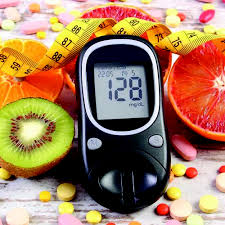-
Contrary to what most people believe, the diet of diabetics is not much different from that of ordinary people, and little change in it will lead to a healthy diet.The best eating pattern in people with diabetes is food intake at 6 servings (three main meals and three in-between meals), so that the duration between two meals is not longer than 3 hours. If the distance between two meals lasts for longer time, it causes a drop in blood glucose; Ordinance of the time of eating has a very positive effect on blood glucose control.
- Food ingredients include macronutrients consisting of carbohydrates, proteins and fats as energy sources as well as micronutrients such as vitamins and minerals.
- Carbohydrates
- About 50-60% of the daily caloric intake should be made from carbohydrates, of which 10 to 15% is preferable to contain simple sugars, and the rest to include compound sugarsBread, cereals and fruits all contain carbohydrates, and sweet foods are part of the carbohydrate group. All carbohydrate foods are converted to glucose after digestion and absorption into the body. One common mistake in people with diabetes is that they think they should not use sugar or must remove rice completely from their diet, but on the other hand they do eat bread and sweet foods like dates and honey, with this thought in mind that these kind of foods contain natural sugar! The amount of total carbohydrate intake is more effective on the blood sugar levels than any other type of carbohydrate received. A diabetic therefore, should be able to control his/her dietary carbohydrate intake.The diabetics diet should contain limited amount of simple sugars and foods with high glycemic index.
- The glycemic index or indicator shows the speed of blood glucose increase after consuming certain amount of carbohydrates. The higher the glycemic index of a foodstuff is, the faster it is absorbed from the gastrointestinal tract, resulting in faster increase of the glucose in blood flow. In diabetes, preferably those low glycemic index carbohydrates should be consumed that could ensure more slow absorption rate and have less effect on blood glucose levels.
- Food fibers are also effective in glycemic index control, and it is recommended for diabetics to use foods with higher fiber amount such as cereals, bran, grains, fruits and vegetables. The beneficial effects of fibers include the reduction of blood cholesterol, prevention of constipation and some digestive disorders as well as gastrointestinal cancers.
- Fat and the diet
- 20 to 30% of daily calories should be supplied from fats. To reduce LDL, you need to reduce the consumption of saturated fatty acids, and the trans fatty acids present in cooked and chopped foods, chips, mayonnaise and hydrogenated solids must be limited. The use of omega-3 fats is very important considering the role it plays in reducing fats in the blood. Omega-3 fats are unsaturated fatty acids, which their first double bond lies in carbon number 3. Important sources of these fats are as follows: Fat Fish, Fish Oil, Sunflower Oil and nuts (Walnuts, Almonds, Hazelnuts, Pistachios, Seeds)
- Proteins in diet From 15 to 20 percent of daily calories should be provided through proteins, which is better to use both plant and animal proteins.
Healthy diet

23
Nov






